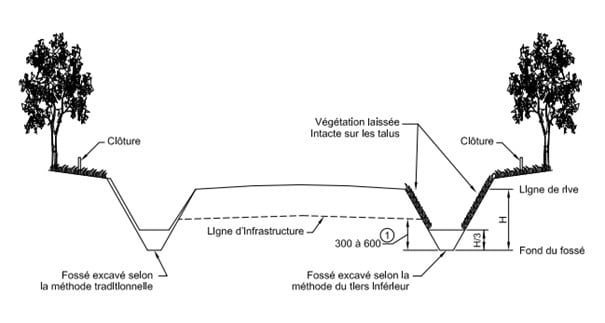If you’re looking to dig a ditch with an excavator, understanding the process and requirements is essential for a successful project. Ditch and trench digging are tasks often entrusted to excavation companies.
So, who better than our experts in earthworks and excavation to share a wealth of information about how to dig a ditch with an excavator? This will be very useful if you plan to dig a ditch or are considering hiring an excavation company to do it for you.
Understanding the benefits of using an excavator over manual tools is crucial for efficient and safe ditch digging.
In this article, we will explore the essential techniques and considerations to effectively dig a ditch with an excavator. From understanding the different types of ditches to the necessary equipment and planning required for successful excavation, our experts will guide you through each step of the process. Whether you’re a DIY enthusiast or considering hiring a professional, this comprehensive guide will provide valuable insights to ensure your ditch digging project is executed efficiently and effectively.
WHAT IS A DITCH?
A ditch is a long depression dug into the ground. Every ditch exists because of human intervention.
DITCH VS TRENCH?
Trenches are characterized by their depth, exceeding their width, while ditches are distinguished by their width, surpassing their depth.
THE ROLE OF A DITCH
Ditches serve to properly drain surface water, especially during rainstorms and snowmelt. They also act as sedimentation and water storage basins. They capture soil particles and reduce the risk of these particles ending up in rivers and lakes. They can even contribute to filtering runoff water.
While trenches act as underground channels, accommodating electrical wiring, sewer lines, and drainage system infrastructure.
THE 4 TYPES OF DITCHES
1- THE SHARED DITCH
A shared ditch serves as a boundary between two adjacent properties.
2- THE PUBLIC OR PRIVATE ROAD DITCH
The public or private road ditch is exclusively used to drain a public or private road, such as a street, bike path, or railway.
3- THE DRAINAGE DITCH
The drainage ditch is used solely for drainage and irrigation of agricultural land.
4- THE IRRIGATION DITCH
The irrigation ditch is designed to supply water to fields, aiding in crop growth and agricultural yield.
SOME THINGS TO KNOW BEFORE DIGGING A DITCH WITH AN EXCAVATOR
Digging a ditch likely requires more planning than you might think. Here are some elements to pay attention to if you have such a project.
DITCH DESIGN
The design of a ditch has a significant impact on its ability to resist erosion and fulfill its role for a long period, without requiring maintenance. For superior performance and durability, it is recommended to:
-
- Minimize the ditch depth (the depth between the infrastructure line and the bottom of the ditch should be between 0.30 and 0.60 m).
-
- Design the side slopes of ditches while respecting as much as possible the angle of repose of the existing soil and vegetation development. Ideally, the slope should be gentler than 2:1.
-
- Design the ditch to have a bottom width between 0.60 and 1.80 m to promote water infiltration and filtration.
WHEN CAN YOU DIG A DITCH WITH AN EXCAVATOR?
The best time to dig a ditch with an excavator is usually after the thawing period ends and before conditions make excavation impossible.
However, it is preferable to carry out excavation work in dry weather to limit sediment transport.
EQUIPMENT NEEDED TO DIG A DITCH
To dig a ditch, you first need a mechanical excavator. This heavy equipment allows the operator to dig the ground and move the excavated earth.
To avoid damaging asphalt, it is advisable to use a wheeled or protected track excavator when working near roads. Additionally, the hydraulic excavator’s bucket should be relatively small to allow the driver to see the bottom of the ditch properly.
To quickly intervene in case of leaks or spills of hydrocarbons or other harmful substances, it is recommended to keep an emergency spill kit on site in case of accidental spills.
It can also be useful to have a laser level to ensure the correct slope and maintain the proper orientation of the ditch. Markers and high-visibility paint can also help the operator dig in the right place.
Consideration of local soil conditions and potential environmental impacts is also critical before beginning any excavation project.
TRUST YOUR WORK TO EXCAVATION CHANTHIER
DO YOU NEED A PERMIT TO DIG A DITCH WITH AN EXCAVATOR?
Before starting to dig a ditch, you have to check if it is necessary to obtain an authorization certificate from the Ministry of Sustainable Development, Environment, and Fight against Climate Change.
A municipal inspector can guide you through the steps.
BEWARE OF UNDERGROUND INFRASTRUCTURES
Many public infrastructures, such as gas and potable water distribution networks, are buried. Even during residential excavation work, it is essential to check if any are present where you plan to dig a ditch with an excavator. For this, you can use a service like Info-Excavation. This way, you might avoid causing damage that would require sewer or aqueduct repairs!
SOME TIPS TO MAKE DITCH DIGGING EASIER
-
- Digging a ditch from the bottom of the slope upwards (from downstream to upstream) makes it easier to give it the correct slope. Not to mention, this will prevent water flow from complicating the work.
-
- If your ditch needs to change direction, it is better to create a curve rather than a right angle. Right angles tend to erode quickly.
A FEW WORDS ABOUT DIGGING AN EXISTING DITCH
The maintenance of a drainage network should not be neglected. In this sense, ditch cleaning should be done periodically.
Debris that has accumulated must be removed, and sometimes you may need to dig an existing ditch to restore its effectiveness.
WHEN SHOULD YOU DIG AN EXISTING DITCH?
Intervention to dig an existing ditch should be planned after observing one of the following situations:
-
- An obstruction to the free flow of water;
-
- An accumulation of more than 150 mm of sediment above the original level of the ditch;
-
- Insufficient depth of the existing ditch to ensure proper drainage (at least 150 mm lower than the infrastructure line).
Regular ditch cleaning is essential to prevent issues such as erosion, flooding, and water pollution caused by clogged ditches. To that effect it is recommended to use the following ditch cleaning method.
USING THE LOWER THIRD METHOD
When possible, the lower third method should be prioritized when cleaning a ditch.
This involves excavating only the lower third of the total depth of the ditch. Above the lower third, the banks are left intact, preserving the existing vegetation.
This method involves clearing the ditch and cutting the turf before starting to dig to a depth no greater than 600 mm below the infrastructure line.
Additionally, once the ditch excavation is complete, the exposed soils should be revegetated with a mixture of herbaceous plants (when conditions permit).

Image illustrant la méthode du tiers inférieur
NEED A DITCH DUG WITH AN EXCAVATOR? EXCAVATION CHANTHIER IS HERE FOR YOU!
Digging a ditch with an excavator can be an efficient and effective way to manage water flow and drainage. By carefully planning your project, selecting the right equipment, and following safety guidelines, you can successfully complete this task while minimizing risks and ensuring quality results. Whether for agricultural purposes, utility installation, or landscaping, knowing how to dig a ditch properly will set you up for success in your excavation endeavors.
Now that you know everything involved in ditch digging, you may realize that it’s better to entrust this task to specialists rather than try to do it yourself.
If that’s the case, you can trust our team. At Excavation Chanthier, we have all the necessary equipment, and our operators are trained and certified. Contact us today to entrust us with your project.


